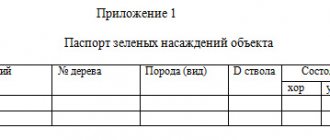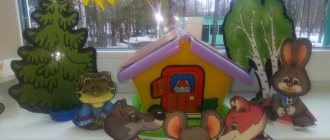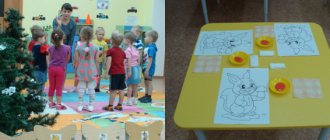Article “Environmental education of preschool children taking into account the Federal State Educational Standard.”
Environmental education of preschool children taking into account the Federal State Educational Standard. Forms and methods of environmental education
The tasks set by the Federal State Educational Standard for preschool pedagogy are aimed at the end result - the formation of an integral spiritual and moral personality. One of the important aspects of this process is environmental education. Only a person who sincerely loves his land, his native land will grow up to be a true patriot of his Motherland. How is environmental education implemented in kindergarten? Environmental problems of our time have an impact on the life and activities of society in general and each individual in particular. They are global in nature and can only be resolved if all people develop an ecological worldview and increase their environmental literacy and culture. In solving this problem, the leading role belongs to environmental education. The first stage of the system of continuous environmental education is preschool environmental education. How and under what conditions children develop in the first months and years of their lives determines not only what level of development they will have, but also whether it is even possible to talk about instilling an environmental culture in them.
Environmental education of preschool children according to the Federal State Educational Standard is a continuous process of children’s development aimed at developing an environmental culture in them. Familiarizing preschoolers with the natural world around them is considered within the educational field of “Cognitive Development” and involves solving such problems as:
— to form primary ideas about objects of the surrounding world, about the properties and relationships of objects of the surrounding world;
— develop the need for experimentation and research of natural objects through the creation of a developing subject-spatial environment;
— to cultivate a humane, emotionally positive, careful, caring attitude towards the natural world and the surrounding world in general.
Preschool children are characterized by visual - imaginative and visual - effective thinking, therefore the principle of my work, which contributes to the development of children’s cognitive interest, is the Chinese folk wisdom: “Tell me - and I will forget, show me - and I will remember, let me act on my own - and I will understand."
In the process of environmental education, children develop cognitive interest in the natural world, curiosity, creative activity, i.e., the child’s personal qualities, which are presented as targets in the Federal State Educational Standard for Education.
In our work we use organized forms of work on environmental education, as well as joint activities of the teacher and children.
Organized: – excursions (to a forest, park, meadow, pond, etc.) – classes (educational, combined, complex), – observations of animals and plants, natural phenomena, human activities in nature. Joint activities: - observations in a corner of nature, work in a corner of nature, - targeted walks in nature, hikes, - reading works of art about nature (poems, short stories, fairy tales), - looking at illustrations in books, environmental tales, pictures from the life of wild animals , artists I.I. Levitan, A.K. Savrasov, V.D. Polenov, I.I. Shishkin, K.F. Yuon and others - stories, conversations of the teacher about animals, plants, inanimate nature. about nature reserves, reserves, natural monuments, etc., – collecting collections, seeds, stones, leaves, – environmental holidays and leisure activities (“Bird Day”, “Earth Day”, “Birthday of the Forest”), – experiments, search activities in an environmental circle or laboratory of a young researcher, - marathons, auctions, promotions, - environmental trainings with discussion and simulation of situations, - games (moving, didactic, theatrical, musical, intellectual), - various types of visual activities on environmental topics.
An excellent way to combine a variety of activities aimed at understanding the world around us is the project method. It provides for preschoolers to carry out practical, purposeful activities and contributes to the formation of their personal life experience in interacting with natural objects.
Working on a project gives the child the opportunity to consolidate theoretical knowledge, feel like a tester, and participate “on an equal footing” with adults in joint cognitive activities. With preschoolers you can implement research, practice-oriented, role-playing, and creative projects. These are usually short-term group or individual projects.
The game provides children with freedom of action, freedom and the opportunity to take initiative. However, to use gaming activities in the process of environmental education, it is necessary to organize them in such a way that there is no threat or harm to wildlife.
An obligatory attribute of children's life are toys that depict natural objects. By playing with them, preschoolers imitate the habits and lifestyle of animals.
A separate type of work on environmental education is the manufacture of toys from natural materials. Children will become familiar with the characteristics of natural objects, and the fact that as a result of such an activity a beautiful, bright toy will be obtained increases interest in these activities.
In kindergarten, story games, practical games, illustration games and dramatizations are practiced. It is very useful to offer children practical games with objects such as sand, water, clay. The purpose of these games is not only to have fun and make a figurine or make a house (splash with water, blow bubbles, etc.), but also to learn the properties of these natural materials.
The group has an environmental center, where children's and encyclopedic literature with natural history and environmental content, experimentation aids, observation diaries, collections, environmental models (“Swamp”, “Antarctica”) and other materials are presented.
We have created a corner of nature where children come into contact with the beautiful world of plants every day, learn to observe, interact with it, care for it and take care of it. Working in a corner of nature has great educational value. Children develop a careful, caring attitude towards nature, develop a responsible attitude towards their responsibilities, and children learn to respect the work of adults. In the process of care, children gain an understanding of the diversity of the plant world, how plants grow and develop, and what conditions need to be created for them.
The concept of modernization of Russian education, in connection with the transition to the Federal State Educational Standard for Education, emphasizes the exclusive role of the family in solving the problems of raising the younger generation. Therefore, working with parents is the most important aspect in the implementation of environmental education, since it is the family that provides the first experience of interaction with nature, introduces them to active activities, and sets an example of attitude towards objects of the flora and fauna. Together with parents, we hold environmental events and holidays that shape the environmental culture of preschoolers. For example, campaigns for landscaping the territory of a preschool educational institution, removing garbage, protecting trees on the site, helping wintering birds, creating toys from waste materials, etc.
Thus, we can conclude that there are broad opportunities for environmental education in preschool settings. Knowledge acquired through direct play, guided by a teacher, helps to form in the child a correct idea of the world, into which he is included not as a master, but as a participant in the natural process of development.
Goals and objectives of environmental education in preschool educational institutions
Preschool age is a unique period in the formation and development of a child. A properly organized upbringing process has a productive effect on the overall development of the child and creates the prerequisites for his further upbringing and education.
Are you an expert in this subject area? We invite you to become the author of the Directory Working Conditions
The general goal of raising preschool children is the full, comprehensive and harmonious development of the child’s personality.
It is very difficult to identify a single goal of environmental education for preschool children, since environmental education is a continuous process that begins from preschool age and continues throughout life.
Note 2
According to the Federal State Educational Standard for Preschool Education, the goal of environmental education for preschool children is the implementation by preschool teachers of a continuous, purposeful, controlled process to develop an environmental culture in children.
Elements of ecological culture of preschool children are:
- respect for the environment
- sustainable knowledge about the surrounding world and the interconnection of all living things
- correct understanding of a “healthy lifestyle” (HLS)
- moral attitudes and ideas about environmental values
- emotional responsiveness to nature and its phenomena
- positive feelings and sensations from communication with the surrounding nature
- desire to explore and learn about the world around us
Finished works on a similar topic
Coursework The purpose and objectives of environmental education 490 ₽ Abstract The purpose and objectives of environmental education 270 ₽ Examination The purpose and objectives of environmental education 250 ₽
Receive completed work or specialist advice on your educational project Find out the cost
The goal of environmental education of preschool children, specified in the Federal State Educational Standard for Preschool Education, is achieved by solving its main tasks:
- Educational objectives:
- formation of a holistic system of knowledge about current environmental problems of the world
learning ways to solve environmental problems
- acquisition of knowledge on the prevention of environmental problems
- Educational tasks:
- formation of motives, habits and needs for environmental behavior
formation of a healthy lifestyle throughout life, a negative attitude towards bad habits
- development of the need for a healthy lifestyle and compliance with environmental rules of behavior
- Developmental tasks:
- development of a system of theoretical and practical knowledge, skills and abilities aimed at studying and assessing the state of the environment
development of skills to preserve and improve the state of the environment.
Goals and objectives of environmental education at school
Note 3
The main goal of environmental education at school is the formation and development of environmental culture and environmental competencies in children.
Environmental education of schoolchildren is aimed at transferring the environmental experience of the older generation. However, this is not always enough for environmental education to be complete and effective. In order to achieve this goal, the student must be an active participant in the educational process and influence his elders and peers.
It should be noted that the environmental goals of education at school are different, depending on the age of the children.
Goals of environmental education of children in primary school:
- fostering a caring and respectful attitude towards the environment
- development of a sustainable desire to observe moral principles in the process of relationships with nature and when using natural resources
- promotion of environmental goals
- engaging in active activities to study the rules of treating nature and how to protect it
The tasks of environmental education for primary school children are similar to the tasks of raising children in preschool educational institutions. However, in addition to educational, educational and developmental types of tasks, there are a number of specific tasks based on the age characteristics and needs of children of primary school age.
Objectives of environmental education in primary school:
- Educational and educational objectives: deepening and expanding existing environmental knowledge
- Behavioral tasks: developing initial environmental skills and abilities
- Cognitive tasks: development of cognitive, creative and social activity of children in the process of environmental activities
- Transformative tasks: aimed at fostering feelings of respect for nature.







